《英语》(新标准)(一起)四年级上册M4
小学英语四年级上册M4学习要点
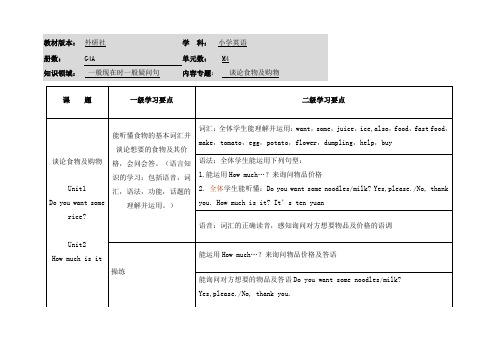
操练
能运用How much…?来询问物品价格及答语
能询问对方想要的物品及答语Do you want some noodles/milk? Yes,please./No, thank you.
运用
模拟在餐馆点餐和商店售货场景。
教材版本:
外研社
学 科:小学英语
册数:
G4A
单元数:
M4
知识领域:
一般现在时一般疑问句
内容专题:
谈论食物及购物
课 题
一级学习要点
二级学习要点
谈论食物及购物
1
Do you want some rice?
Unit2
How much is it
能听懂食物的基本词汇并谈论想要的食物及其价格,会问会答。(语言知识的学习:包括语音,词汇,语法,功能,话题的理解并运用。)
词汇:全体学生能理解并运用:want,some,juice,ice,also,food,fast food,make,tomato,egg,potato,flower,dumpling,help,buy
语法:全体学生能运用下列句型:
1.能运用How much…?来询问物品价格
2.全体学生能听懂:Do you want some noodles/milk? Yes,please./No, thank you. How much is it? It’s ten yuan
M3M4同步阶段测_外研新标准版四年级英语上册
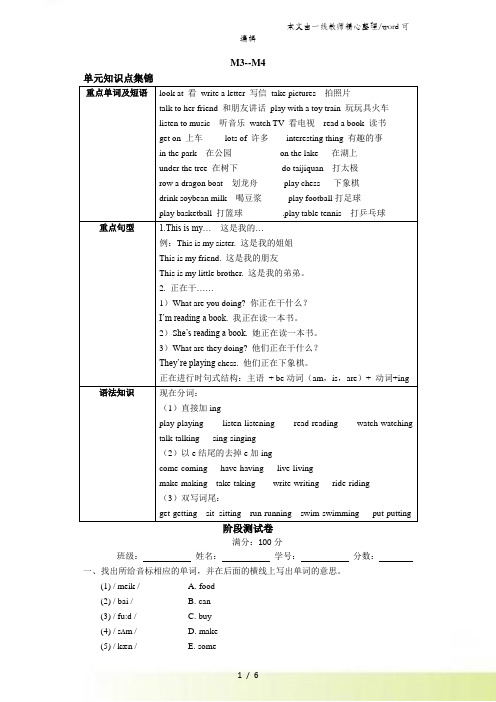
M3--M4单元知识点集锦重点单词及短语look at 看write a letter 写信take pictures 拍照片talk to her friend 和朋友讲话play with a toy train 玩玩具火车listen to music 听音乐watch TV 看电视read a book 读书get on 上车lots of 许多interesting thing 有趣的事in the park 在公园on the lake 在湖上under the tree 在树下do taijiquan 打太极row a dragon boat 划龙舟play chess 下象棋drink soybean milk 喝豆浆play football打足球play basketball 打篮球.play table tennis 打乒乓球重点句型 1.This is my…这是我的…例:This is my sister. 这是我的姐姐This is my friend. 这是我的朋友This is my little brother. 这是我的弟弟。
2. 正在干……1)What are you doing? 你正在干什么?I’m reading a book. 我正在读一本书。
2)S he’s reading a book. 她正在读一本书。
3)What are they doing? 他们正在干什么?They’re playing chess. 他们正在下象棋。
正在进行时句式结构:主语+ be动词(am,is,are)+ 动词+ing 语法知识现在分词:(1)直接加ingplay-playing listen-listening read-reading watch-watchingtalk-talking sing-singing(2)以e结尾的去掉e加ingcome-coming have-having live-livingmake-making take-taking write-writing ride-riding(3)双写词尾:get-getting sit -sitting run-running swim-swimming put-putting阶段测试卷满分:100分班级:姓名:学号:分数:一、找出所给音标相应的单词,并在后面的横线上写出单词的意思。
新标准英语小学四年级上册M4M5模块测试题
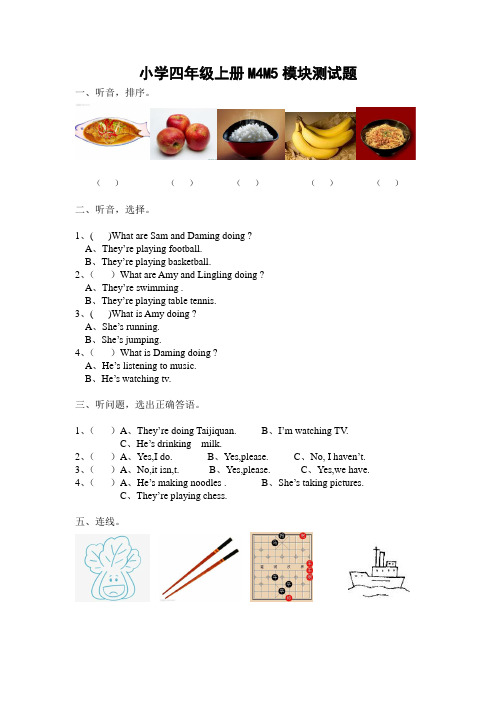
小学四年级上册M4M5模块测试题一、听音,排序。
()()()()()二、听音,选择。
1、( )What are Sam and Daming doing ?A、They’re playing football.B、They’re playing basketball.2、()What are Amy and Lingling doing ?A、They’re swimming .B、They’re playing table tennis.3、( )What is Amy doing ?A、She’s running.B、She’s jumping.4、()What is Daming doing ?A、He’s listening to music.B、He’s watching tv.三、听问题,选出正确答语。
1、()A、They’re doing Taijiquan. B、I’m watching TV.C、He’s drinking milk.2、()A、Yes,I do. B、Yes,please. C、No, I haven’t.3、()A、No,it isn,t. B、Yes,please. C、Yes,we have.4、()A、He’s making noodles . B、She’s taking pictures.C、The y’re playing chess.五、连线。
chess vegetables boat chopsticks四、把问句和正确的答语相连。
1、Do you want some rice ? I’m cooking vegetables.2、What are they doing ? Yes,we have.3、What are you doing ? They’re doing Taijiquan.4、Have you got fast food in england? No , thank you .六、根据图片选择。
小学英语新外研版(一起)四年级上册M4U1教案
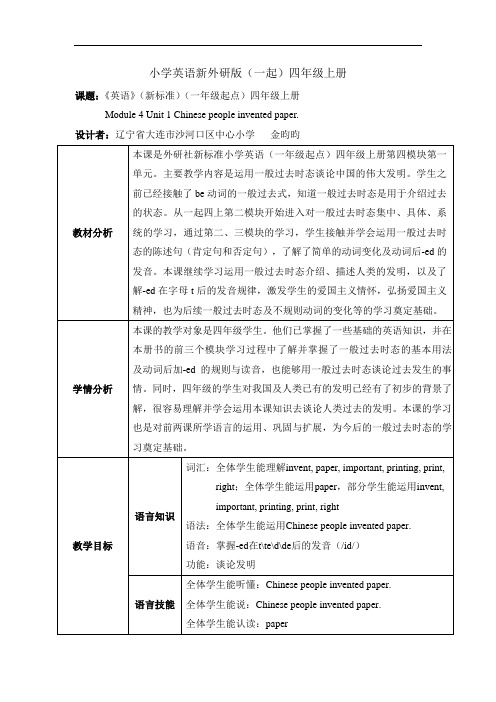
小学英语新外研版(一起)四年级上册课题:《英语》(新标准)(一年级起点)四年级上册
Module 4 Unit 1 Chinese people invented paper.
设计者:辽宁省大连市沙河口区中心小学金昀昀
2.(拓展训练)这些发明你知道吗?
教师出示“电话、收音机和篮球”这些贴近学生生活的
图片,并提问“你知道是谁(哪国人)发明的吗?”
PPT第27页
小结
与
布置作业(2分钟)1.小结
T: Now let’s look at the blackboard, what did we learn
today?
教师引导学生总结本课所学目标语句、词语及用法。
2. 布置分层作业,学生自主选做。
套餐A:抄写词汇、语句各4个;跟读课文2遍;
收集外国人的发明。
套餐B:抄写词汇、语句各2个;自读课文2遍;
收集外国人的发明。
套餐C:在本上写出你所喜欢的两种中国发明;
背诵课文;收集外国人的发明。
PPT第28页。
《英语》(新标准)(一起)四年级上册M4

《英语》(新标准)一起第七册M4Module 4 Unit 1 Chinese people invented paper.四方区教研室王馨悦一、教学目标与要求1、知识目标Words: important , paper , newspaper , invented , pringting , printedSentences: Paper is important.Chinese people invented …….Chinese people didn’t invent …….2、能力目标Help the students use these words and sentences inactivities and daily life.Help the students to know some greating inventions.Help the students to learn the past indefinite tense.2、情感态度目标Inspire the students’ interest.Inspire the students to love our homeland .二、教学重点To master the basic sentence “Chinese people invented…….”To master the past indefinite tense “invent-invented , print-printed”To talk about what Chinese people invented.三、教学难点To talk about what Chinese people didn’t invent.To use these words and sentences in the past indenfinite tense correctly.四、课前准备Radio , cards , small pictures , multimedia五、教学过程Step 1 Warm up教师通过着急的找卡片的活动创设情境让学生感知important。
M4U7Howmanystarsdoeseachgrouphave四年级英语上学期课件(教科版广州)
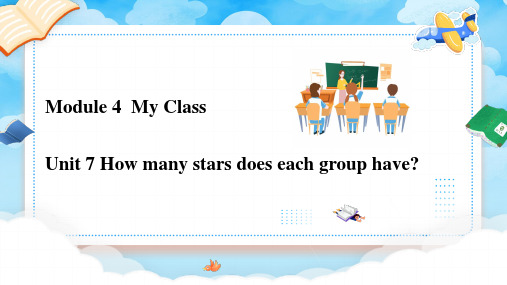
学习目标
1.能熟练地听、说、读以下单词:Star,class,does,group,blackboard,winner. 2.能正确朗读、理解本模块的句型: ① How many(stars)does (each group) have? It has... ② How many... are there? There are... ③What is your favourite subject? My favourite subject is....I like... best. ④ I like/ love to.... ⑤ How many subjects do you have? I/We have .../ (3)学习语音:掌握字母组合c, o-e, o, or, oa, ow, ou在单词中的读音。
一般现在时一般现在时定义:表示经常发生的动作或存在的状态。 一般现 在时的用法:
①表示经常性或者习惯性的动作,常与always, often, usually, every day,
sometimes等词连用。
如: He always rides a bike.
They often help me.
不是每个人都是赢家。
Vocabulary
Chinese /tʃaɪˈniːz/ 中国的;中国人;中国人的;汉语;语文
【拓展】China 中国 in China 在中国 【例句】Chinese live in China and speak Chinese.
中国人住在中国,讲汉语。
Vocabulary
Let me see. Group 1 has eighty stars. Group 2 has sixty-six stars. Group 3 has seventy-five stars.
四年级上册英语(外研版)M4

noodles with meat and potato 土豆烧肉面
How much...? ......多少钱?
How much is it? 它多少钱? It’s ten yuan. 10 元。
flower [ˈflaʊə(r)] 花 The flower is ten yuan. flower shop 花店
Do you want some rice? 你想要一些米饭吗?
juice [dʒuːs] 果汁
apple juice 苹果汁 orange juice 橘子汁
ice [aɪs] 冰,冰块 ice cream 冰淇淋 juice with ice 加冰的果汁
also [ˈɔːlsəʊ] 也 It is also very nice. 它也很美味。 It is very nice too.
food [fuːd] 食物
fast food 快餐 Chinese fast food 中式快餐
green food 绿色食品 junk food 垃圾食物 dog food 狗粮
make [meɪk] 制作
make a kite 制作风筝 make a cake 制作蛋糕
make noodles 制作面条
dumpling [ˈdʌmplɪŋ] 水饺 map [help] 帮助,帮忙
Can we help you? 我们可以帮助您吗? Of course. 当然。
buy [baɪ] 买 buy some eggs 买些鸡蛋
tomato [təˈmɑːtəʊ] 番茄,西红柿
复数tomatoes
tomato soup 番茄汤 tomato juice 番茄汁
一年级起点外研版四年级英语上册(最新版)
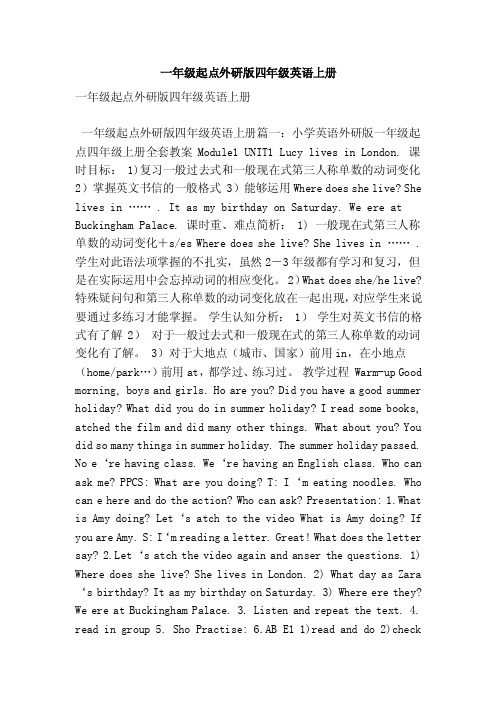
一年级起点外研版四年级英语上册一年级起点外研版四年级英语上册一年级起点外研版四年级英语上册篇一:小学英语外研版一年级起点四年级上册全套教案 Module1 UNIT1 Lucy lives in London. 课时目标: 1)复习一般过去式和一般现在式第三人称单数的动词变化2)掌握英文书信的一般格式 3)能够运用Where does she live? She lives in …… . It as my birthday on Saturday. We ere at Buckingham Palace. 课时重、难点简析: 1) 一般现在式第三人称单数的动词变化+s/es Where does she live? She lives in …… . 学生对此语法项掌握的不扎实,虽然2-3年级都有学习和复习,但是在实际运用中会忘掉动词的相应变化。
2)What does she/he live? 特殊疑问句和第三人称单数的动词变化放在一起出现,对应学生来说要通过多练习才能掌握。
学生认知分析: 1)学生对英文书信的格式有了解 2)对于一般过去式和一般现在式的第三人称单数的动词变化有了解。
3)对于大地点(城市、国家)前用in,在小地点(home/park…)前用at,都学过、练习过。
教学过程 Warm-up Good morning, boys and girls. Ho are you? Did you have a good summer holiday? What did you do in summer holiday? I read some books, atched the film and did many other things. What about you? You did so many things in summer holiday. The summer holiday passed. No e‘re having class. We‘re having an English class. Who can ask me? PPCS: What are you doing? T: I‘m eating noodles. Who can e here and do the action? Who can ask? Presentation: 1.What is Amy doing? Let‘s atch to the video What is Amy doing? If you are Amy. S: I‘m reading a letter. Great! What does the letter say? 2.Let‘s atch the video again and anser the questions. 1) Where does she live? She lives in London. 2) What day as Zara ‘s birthday? It as my birthday on Saturday. 3) Where ere they? We ere at Buckingham Palace. 3. Listen and repeat the text. 4. read in group 5. Sho Practise: 6.AB E1 1)read and do 2)checkthe anser 7. Talk about your birthday. It as my birthday on Monday. We ere at Guanxiangshan Park. Who can talk about yours?8.Book Practise3 1)give an example 2)do in pairs 3)sho 9.AB E3 E4 1)ask and aner 2)sho 4)rite don 板书: Module 1 Unit 1 Lucy lives in London What is she doing? She‘s reading a letter. What does she live ? She lives in London. 作业: 1)listen and repeat the text 5 times 2)retell the ords. Module1 UNIT2 I ve got a ne friend. 教学目标: 5. 阅读和学写英文信及回信 6. 复习现在时态和过去时态教学重难点及突破措施: 5. 英文信格式 6. 含有be 动词的过去时态句型. 措施: 5. 强调英文信称呼,正文,结束语,写信人都顶格写 6. 含有be动词的句子变过去时: am /is变为 as ; are变为ere . 1.text: .Listen and repeat. ● Have the students dra a picture of something they on. They must take turns to guess the other student‘s picture. Examples A: I‘ve got a picture of something. B: Is it a pet? A: No, it isn‘t. B: Is it a toy? A: Yes. B: Is it a toy train? A: No. B: Is it a toy car? A: Yes, it is. 一年级起点外研版四年级英语上册篇二:外研社版新标准小学英语唱“Hello”歌师生互相问候Hello! /Hi! 学生将胸卡戴在胸前,分别起立做自我介绍。
新标准英语四年级上册m1-5中英文
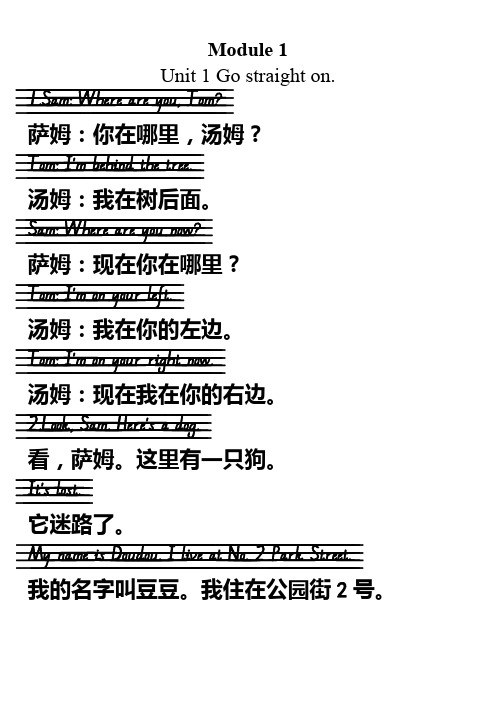
Module1Unit1Go straight on.1.Sam:Where are you,Tom?萨姆:你在哪里,汤姆?Tom:I’m behind the tree.汤姆:我在树后面。
Sam:Where are you now?萨姆:现在你在哪里?Tom:I’m on your left.汤姆:我在你的左边。
Tom:I’m on your right now.汤姆:现在我在你的右边。
2.Look,Sam.Here’s a dog.看,萨姆。
这里有一只狗。
It’s lost.它迷路了。
My name is Doudou.I live at No.2Park Street.我的名字叫豆豆。
我住在公园街2号。
Excuse me.Where’s No.2Park Street,please?打扰一下。
请问公园街2号在哪里?Turn left.向左转。
Go straight on.直着走。
Turn right.向右转。
It’s next to a supermarket.And it’s beside the cinema.它紧靠一家超市。
它在电影院旁边。
Thank you.Bye-bye.谢谢你。
再见。
Goodbye.再见。
Thank you so much!非常感谢你们!You’re welcome!不客气!Unit2It's at the station. 1.Lingling:Where’s Sam?玲玲:萨姆在哪里?Daming:He’s behind the door.大明:他在门后面。
2.Where’s the train?火车在哪里?It’s up the hill.它在上山。
Where’s the train?火车在哪里?It’s down the hill.它在下山。
Where’s the train?火车在哪里?It’s near the house.它在房屋附近。
Where’s the train?火车在哪里?It’s at the station.它在车站。
外研版小学英语(一年级起点)四年级上册Module4 Unit2 参考教案
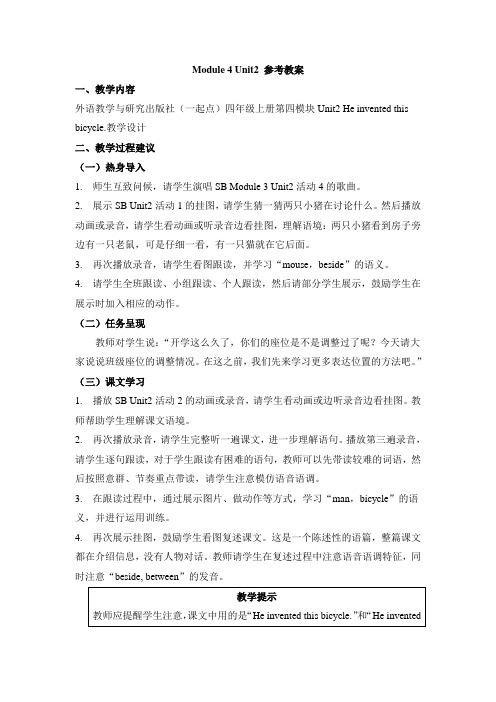
Module 4 Unit2 参考教案一、教学内容外语教学与研究出版社(一起点)四年级上册第四模块Unit2 He invented this bicycle.教学设计二、教学过程建议(一)热身导入1.师生互致问候,请学生演唱SB Module 3 Unit2活动4的歌曲。
2.展示SB Unit2活动1的挂图,请学生猜一猜两只小猪在讨论什么。
然后播放动画或录音,请学生看动画或听录音边看挂图,理解语境:两只小猪看到房子旁边有一只老鼠,可是仔细一看,有一只猫就在它后面。
3.再次播放录音,请学生看图跟读,并学习“mouse,beside”的语义。
4.请学生全班跟读、小组跟读、个人跟读,然后请部分学生展示,鼓励学生在展示时加入相应的动作。
(二)任务呈现教师对学生说:“开学这么久了,你们的座位是不是调整过了呢?今天请大家说说班级座位的调整情况。
在这之前,我们先来学习更多表达位置的方法吧。
”(三)课文学习1.播放SB Unit2活动2的动画或录音,请学生看动画或边听录音边看挂图。
教师帮助学生理解课文语境。
2.再次播放录音,请学生完整听一遍课文,进一步理解语句。
播放第三遍录音,请学生逐句跟读,对于学生跟读有困难的语句,教师可以先带读较难的词语,然后按照意群、节奏重点带读,请学生注意模仿语音语调。
3.在跟读过程中,通过展示图片、做动作等方式,学习“man,bicycle”的语义,并进行运用训练。
4.再次展示挂图,鼓励学生看图复述课文。
这是一个陈述性的语篇,整篇课文都在介绍信息,没有人物对话。
教师请学生在复述过程中注意语音语调特征,同时注意“beside, between”的发音。
(四)训练巩固1.完成SB Unit2活动3。
教师说明活动要求:观察图片,对图片中人物的位置关系进行问答。
先请学生朗读例句。
然后请学生两人一组,仿照例句开展练习。
鼓励学生针对图中所有人物的位置进行问答。
最后请部分学生展示。
2.完成SB Unit2活动4歌曲的学习。
小学英语外研版(一起)四上M4知识点总结

Module 4知识点总结一、短语:1. Chinese people2. invent printing3. print newspapers4. invent paper5. look at6. beside the house7. in front of8. between the two cars9.a week ago二、句子:1. Chinese people invented many important things.2. Chinese people invented paper.3. We print books and newspapers4. That’s right.5. I printed our class newspaper yesterday.6. Look, it’s between the chairs.7. Chinese people didn’t invent bicycle.8. He invented this bicycle.9. The mouse is in front of the cat.10. Look at the man beside the bicycle.11. He was from the UK.12. What a good idea! 一、短语意思:1. 中国人2. 发明印刷术3. 印报纸4. 发明纸5. 看6. 在房子旁边7. 在......前面8. 在两辆车中间9. 一周以前二、句子意思:1. 中国人发明了许多重要的事物。
2. 中国人发明了纸。
3. 我们印刷书和报纸。
4. 没错。
5. 昨天我印刷了班报。
6. 看,它在椅子中间。
7. 中国人没有发明自行车。
8. 他发明了这辆自行车。
9. 老鼠在猫的前面。
10. 看那个在自行车旁边的人。
11. 他曾来自英国。
12. 多好的主意啊!13. Chinese people invented printing for us.14.Now the pen is between the ruler and the pencil.15.Who was in front of you last Monday. 13. 中国人为我们发明了印刷术。
M4 Robots Unit1Robots will do everything.
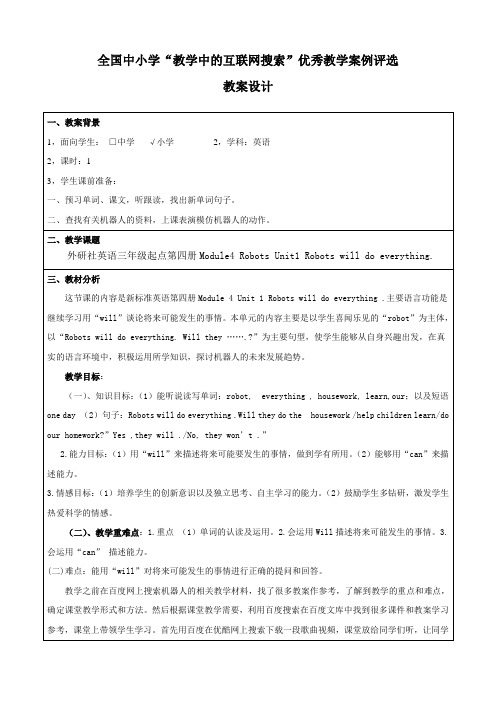
教学目标:
(一)、知识目标:(1)能听说读写单词:robot,everything , housework, learn,our;以及短语one day(2)句子:Robots will do everything .Will they do the housework /help children learn/do our homework?”Yes ,they will ./No, they won’t .”
5.看视频学习,教授板ok at the screen.Will they do the housework?老师领读单词两遍,板书单词.开火车读,小组读。
领读句子,同时板书Will they…?让学生跟读,再让学生回答
1.出示机器人图片教授robotLook here. What’s this? It’s =%BB%FA%C6%F7%C8%CB%CB%B5%BB%B0&in=4794&cl=2&lm=-1&st=-1&pn=3&rn=1&di=68190228075&ln=1940&fr=&fm=result&fmq=1331645189296_R&ic=0&s=0&se=1&sme=0&tab=&width=&height=&face=0&is=&istype=2#pn3&-1&di68190228075&objURLhttp%3A%2F%%2Ftech%2Fimages%2Fattachement%2Fjpg%2Fsite3%2F20090317%2F001aa0e28af90b29857936.jpg&fromURLhttp%3A%2F%%2Ftech%2Fcontent%2F2009-03%2F17%2Fcontent_3639557_2.htm&W500&H288&T11010&S24&TPjpg
新版广州版小学英语四年级上册M3M4教案及练习题

一、听力训练二、 Module3-Module4 重点单词游泳池在,,面运有教公室十二二十黑板利者;家中国的;中国人数学最好写故事关于;大,, 呢?你呢?唱歌歌曲体育运世界三、 Module3-Module4 重点句型根据中文提示把句子充完整。
新课标第一网1. Let me you our new school.( show)is your classroom? ( 哪儿 )–It is there, next the library.〔那,靠近〕there a swimming pool?〔有〕--Yes,it’s the playground.(在⋯⋯面),we sometimes PE lessons there.(上)classrooms are there in your school?(多少)--Our school thirty-eight classrooms.(有)5.How many English teachers in your school? ( there be)6. --Look the blackboard. ( 看 ),How many stars each group? (do, have)--Let me( 想想 )。
Group 1eighty stars.( have)7.you are the winner. ( 所以 )8.-How many(学科 ) do you have? –We have seven(学科 ) .9.--What ’syour subject? (最喜欢的 )--Chinese. I like(write) stories. ( 喜欢写 ).〔你呢〕?-- I English. (最喜欢 )新 -课 -标 -第 -一 -网课堂训练:1)判断以下单词划线局部读音是否相同,相同填“ T〞,不同填“ F〞.〔〕 1. right night〔〕 2. nine is〔〕 3. leg school〔〕 4. girl bird〔〕 5. like five〔〕 6. can coat〔〕 7. no on〔〕 8. for doctor〔〕 9. road boat〔〕 10. home box2)选出正确的选项,补全单词。
外研英语(一起)四年级上M4知识点及基础测试
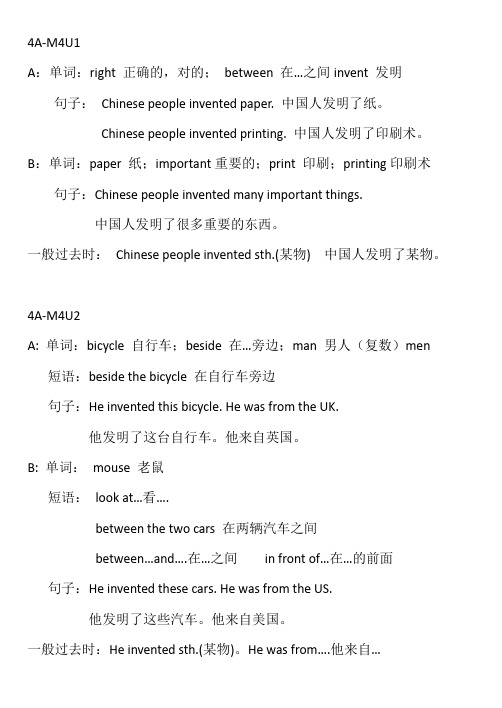
A:单词:right 正确的,对的;between 在…之间invent 发明句子:Chinese people invented paper. 中国人发明了纸。
Chinese people invented printing. 中国人发明了印刷术。
B:单词:paper 纸;important重要的;print 印刷;printing印刷术句子:Chinese people invented many important things.中国人发明了很多重要的东西。
一般过去时:Chinese people invented sth.(某物) 中国人发明了某物。
4A-M4U2A: 单词:bicycle 自行车;beside 在…旁边;man 男人(复数)men 短语:beside the bicycle 在自行车旁边句子:He invented this bicycle. He was from the UK.他发明了这台自行车。
他来自英国。
B: 单词:mouse 老鼠短语:look at…看….between the two cars 在两辆汽车之间between…and….在…之间in front of…在…的前面句子:He invented these cars. He was from the US.他发明了这些汽车。
他来自美国。
一般过去时:He invented sth.(某物)。
He was from….他来自…A:正确的,对的;__________在…之间___________ 发明_________ 纸;_________重要的;___________ 印刷;印刷术______________ 句子:中国人发明了纸。
__________________________________ 中国人发明了印刷术。
________________________________B句子:中国人发明了很多重要的东西。
小学英语人教新起点版四年级上册Unit 4课文+单词+知识点讲解(含视频和音频,可下载)
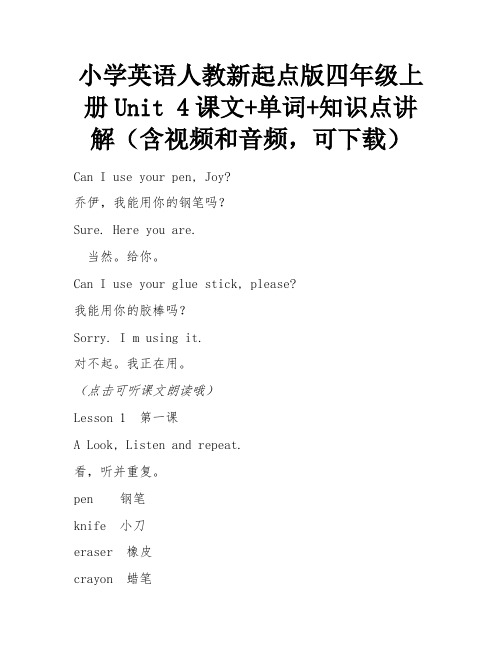
小学英语人教新起点版四年级上册Unit 4课文+单词+知识点讲解(含视频和音频,可下载)Can I use your pen, Joy?乔伊,我能用你的钢笔吗?Sure. Here you are.当然。
给你。
Can I use your glue stick, please?我能用你的胶棒吗?Sorry. I m using it.对不起。
我正在用。
(点击可听课文朗读哦)Lesson 1 第一课A Look, Listen and repeat.看,听并重复。
pen 钢笔knife 小刀eraser 橡皮crayon 蜡笔scissors 剪刀glue stick 胶棒paper 纸Bill, Lily and Joy go to the supermarket.比尔、丽丽和乔伊去超市。
I need a knife and some pens.我需要一把刀和一些钢笔。
I need an eraser, a glue stick and somepaper. 我需要一块橡皮、一根胶棒和一些纸。
I need some crayons and a pair of scissors.我需要一些蜡笔和一把剪刀。
Do you have scissors?你有剪刀吗?Sure, here you are.当然,给你。
B Let s role-play.一起角色扮演吧。
Do you have erasers?你们有橡皮吗?Yes, we do.是的,我们有。
Do you have crayons?你们有蜡笔吗?Sorry, we don t.对不起,我们没有。
(点击可听课文朗读哦)Lesson 2 第二课A Look, listen and repeat.看,听并重复。
Bill: Hi, Andy. Can I use your glue stick, please?你好,安迪。
我能用你的胶棒吗?Andy: Sorry. I m using it.对不起。
四年级上册英语同步拓展-M4 Unit 2 At Century Park讲义 牛津上海版(一起)
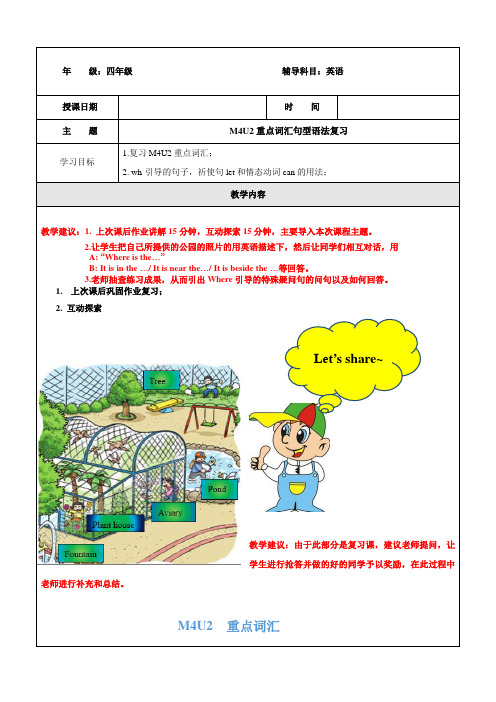
教学建议:1. 上次课后作业讲解15分钟,互动探索15分钟,主要导入本次课程主题。
2.让学生把自己所提供的公园的照片的用英语描述下,然后让同学们相互对话,用A: “Where is the…”B: It is in the …/ It is near the…/ It is beside the …等回答。
3.老师抽查练习成果,从而引出Where引导的特殊疑问句的问句以及如何回答。
1.上次课后巩固作业复习;2. 互动探索Let’s share~教学建议:由于此部分是复习课,建议老师提问,让学生进行抢答并做的好的同学予以奖励,在此过程中老师进行补充和总结。
M4U2 重点词汇【知识梳理1】sketchbook n. 素描本e.g. There is a sketchbook on the desk. 桌子上面有一本素描本。
She picks up her sketchbook. 她拿起了她的素描本。
【知识拓展】 storybook 故事书 fiction 小说 notebook 笔记本 【知识梳理2】cap n. 帽子【课文索引】I have a cap and a bottle of water. 我有一定帽子和一瓶水。
e.g. He put his cap and overcoat on a chair. 他把帽子和大衣放在一张椅子上。
【知识拓展】hat 帽子(带沿的帽子)Hat Cap 批注:提醒孩子hat 和cap 形状的区别。
【知识梳理3】camera n. 照相机【课文索引】I have a camera . 我有一台照相机。
e.g. Mary asked her mother to buy her a new camera because her old was broken. 玛丽让她妈妈给她买一个新的照相机因为她的旧的坏了。
【知识梳理4】aviary n. 鸟舍【课文索引】There are some aviaries next to it. 在它旁边有一些鸟舍。
- 1、下载文档前请自行甄别文档内容的完整性,平台不提供额外的编辑、内容补充、找答案等附加服务。
- 2、"仅部分预览"的文档,不可在线预览部分如存在完整性等问题,可反馈申请退款(可完整预览的文档不适用该条件!)。
- 3、如文档侵犯您的权益,请联系客服反馈,我们会尽快为您处理(人工客服工作时间:9:00-18:30)。
《英语》(新标准)一起第七册M4Module 4 Unit 1 Chinese people invented paper.四方区教研室王馨悦一、教学目标与要求1、知识目标Words: important , paper , newspaper , invented , pringting , printedSentences: Paper is important.Chinese people invented …….Chinese people didn’t invent …….2、能力目标Help the students use these words and sentences inactivities and daily life.Help the students to know some greating inventions.Help the students to learn the past indefinite tense.2、情感态度目标Inspire the students’ interest.Inspire the students to love our homeland .二、教学重点To master the basic sentence “Chinese people invented…….”To master the past indefinite tense “invent-invented , print-printed”To talk about what Chinese people invented.三、教学难点To talk about what Chinese people didn’t invent.To use these words and sentences in the past indenfinite tense correctly.四、课前准备Radio , cards , small pictures , multimedia五、教学过程Step 1 Warm up教师通过着急的找卡片的活动创设情境让学生感知important。
通过“头脑风暴”让学生思考什么是对自己重要的,扩展运用important。
1、Where is my card?It’s very important for me.2、Are TVs important ?Say a chant.3、What is important for you (in our lives)?Step 2 Presentation and practice1、老师通过抢答趣味操练newspaper,并为后面的Chinese/English people 作铺垫。
T: Books are made of paper.Show some things:paper telephone/boat/planeT:.Look,some important news on this paper.Show the newspaper.T:.猜报纸Game: Chinese or English newspaper.2.读报纸,运用学生想要了解蔡伦的信息差导入重点句型Chinese people invented paper。
通过对发音的渗透,引导学生归纳以t结尾的词加ed的发音规则。
导入CailunT: Who is he?What do you know about him?导入invent发音in-tentinvented渗透发音ed/id/,want—wantedprait—praited3.导入:Cailun invented paper.Chinese people invented paper.Chinese people are very clever.替换kites/chopsticksPeople invented …….以People invented…….展开讨论,降低难度,使学生在用中操练重点词句。
避免机械操练。
4.谈论四大发明,导入printingChinese people invented ……导入printing5.Let me print sth for you.黄金眼:What did they print?通过用印泥印图片帮助学生理解print与draw,paint的区别。
黄金眼游戏,锻炼学生的观察记忆和合作能力。
Step 3 Consolidation and extension1.Listen and find out the word “invented”2.Listen and repeat the sentences with “invented”3.Read and finish the sentences.do some exercises .完成活动手册练习通过阅读完成句子训练学生的读写能力,为段落写作做铺垫4.出示物品图片,自行车、电视、电话、丝绸、飞机。
T:.Who invented bicycles?导入Chinese people didn’t invent …….T: Guess and choose:Which thing was invented by Chinese people?在游戏中帮助学生理解didn’t的意思。
本环节利用与学生之间的信息差,即操练句型又获取有关发明的知识,拓宽学生知识面。
Step 4 SummaryT: What have you learn today?让学生自己总结今天学到了什么Step 5 HomeworkListen to the tape and repeat the textCopy the sentences.Step 6 Blackboard designUnit 1 Chinese people invented paper.Chinese people invented paper.Printing.Chinese people didn’t invent …….Module 4 Unit 2 He invented this bicycle in 1839青岛慧水路小学张艳艳一、教学目标与要求1、知识与能力目标Knowledge target:Words: bicycle trueSentences: He invented this bicycle in 1839.Ability target:Help the students to know some great inventions.Help the students to learn the past tense.2、情感态度目标Inspire the students to love our homeland .通过学习中外的伟大发明,培养学生的爱国主义精神和民族自豪感。
二、教学重点及难点Main Points:To master the basic sentence “He invented this bicycle in 1839.”To talk about what Chinese people invented and what English people invented.Difficult Points:To talk about what Chinese\ English \ American people didn’t invent.To use words and sentences in the past tense correctly.三、课前准备(包括教学与学具的准备)VCD\课件\单词卡片四、教学过程Step 1 Warm up1、智慧树课件出示大树图片,树上有单词,快速说出单词并说出单词的过去式。
(通过快速说单词环节,复习单词的过去式)2、ChantInvent invent inventedChinese people invented paper.Print print printedI printed this newspaper.学生在老师的指导下拍手读一读chant,对上节课内容的回顾,又有利于帮助学生进入状态学习新知识。
Step 2 Presentation and practice㈠单词学习1、bicycleT: What did you do yesterday? S:……T: I rode my bicycle yesterday. Look, this is my bicycle.课件出示一辆自行车和单词bicycle。
学生跟读单词。
2、wheel(老师出示两张图片,第一张是现在的自行车,第二张是世界上最初发明的自行车。
)T: Look at these two bicycles. Can you find the difficults between them?S:老式自行车,一个轮子大,一个轮子小。
T: Yes, one wheel is very big, one is small.老师用课件突出显示自行车轮子,并出示单词wheel。
领读单词。
㈡课文学习1、listen and answer my questions.Who invented this bicycle?Is he a Chinese?When did he invented this bicycle?通过让学生带着问题听录音,解决课文的主要问题。
同时引出句型He invented this bicycle in 1839.老师提出问题并播放录音,然后用课件呈现问题如下:Who invented this bicycle?Is he a Chinese?When did he invented this bicycle?He invented this bicycle in _______.呈现重点句型He invented this bicycle in 1839.领读。
2、listen and repeat跟读课文,老师注意强调语音和语调。
3、Read and complete the passage._____ _____this picture. It’s a _____. Look at the man _____ the bicycle. He was _____. He _____ this bicycle in _____.4、PractiseTrue or isn’t true.(要求学生用手势来表示That’s true. That isn’t true.)理解true的意思T: An American invented this bicycle, is that true?S: No, that isn’t true.边说边做手势。
